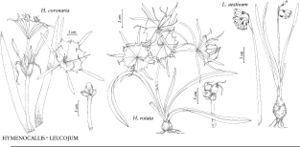Leucojum
Sp. Pl. 1: 289. 1753.
Gen. Pl. ed. 5, 140. 1754.
| Taxon | Illustrator ⠉ | |
|---|---|---|
 | Hymenocallis coronaria Hymenocallis rotata Leucojum aestivum | Yevonn Wilson-Ramsey Yevonn Wilson-Ramsey Yevonn Wilson-Ramsey |
Herbs, perennial, scapose, from brown, globose to ovoid, tunicate bulb. Leaves several; blade linear-ligulate, base sheathing. Scape stout, hollow [slender, solid]. Inflorescences umbellate, 2–5 (–7) -flowered, spathaceous; spathe bracts 2, free or entirely adnate on 1 side, appearing monophyllous. Flowers nodding; perianth campanulate; tepals 6, distinct, oblanceolate to ovate, equal; stamens 6, distinct; anthers basifixed, conic, longer than filaments, blunt apically, dehiscing by terminal pores; ovary inferior, green, 3-locular, globose, septal nectaries present; style filiform or clavate, exceeding anthers; stigma minutely capitate. Fruits capsular, erect, pyriform to subglobose, dehiscence loculicidal; pericarp somewhat fleshy. Seeds numerous, black, appendages absent. x = 7, 8, 9, 10, 11, 12.
Distribution
Introduced; c, sw Europe, nw Africa, and sw Asia (Armenia), and sw Asia (Crimea), elsewhere
Discussion
Species ca. 10 (1 in the flora).
Several species of Leucojum are cultivated for their flowers. Although other species such as L. autumnale Linnaeus (autumn snowflake) and L. vernum Linnaeus (spring snowflake) may persist in old gardens, only the commonly cultivated L. aestivum (summer snowflake) is known definitely to be naturalized in the flora. There are unconfirmed reports that L. vernum is naturalized in the panhandle area of Florida.
Leucojum is sometimes confused with Galanthus, a spring-flowering, Eurasian relative, but it differs in that Leucojum has perianth segments that are all equal in size, and hollow stems that are usually taller and bear 2–5 flowers. In the southern states, the common name snowdrop, which usually refers to Galanthus species, is applied to Leucojum.
Leaves and bulbs of Leucojum contain the alkaloids lycorine and galanthamine, and are poisonous.
Selected References
None.
Lower Taxa
"broad" is not a number."thicker" is not a number.